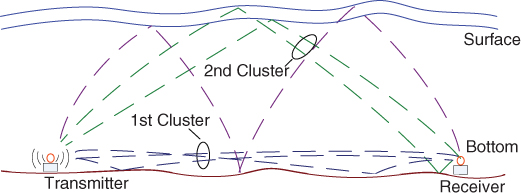Chapter 11OFDM in Deep Water Horizontal Communications
For the OFDM receiver designs in Chapters 9 and 10, one underlying assumption is that the channel delay spread is less than the guard time and hence there is no interblock interference (IBI). This is suitable for shallow water acoustic channels or deep water vertical channels, where the channel delay spread is often around several tens of milliseconds. This chapter focuses on two scenarios where the channel consists of long separately clusters, leading to an extremely large delay spread, e.g., on the order of seconds. The first scenario is in deep-water horizontal channel, as illustrated in Figure 11.1, where the transmitter and receiver are horizontally separated, and could also be at different water depths. The second scenario is an underwater broadcasting networking, where multiple surface nodes broadcast the same information to underwater nodes.

Figure 11.1 Illustration of deep water acoustic communication channels.
This line of research is motivated by the strong need of forming acoustic local area networks (ALAN) in deep oceans, as illustrated in Figure 11.2. One example is the cellular network in the Atlantic Undersea Test and Evaluation Center (AUTEC) located around Andros Island near the Tongue of the Ocean, Bahamas, where fixed nodes are deployed in an area of size km. The water depth is about km to km, ...
Get OFDM for Underwater Acoustic Communications now with the O’Reilly learning platform.
O’Reilly members experience books, live events, courses curated by job role, and more from O’Reilly and nearly 200 top publishers.

